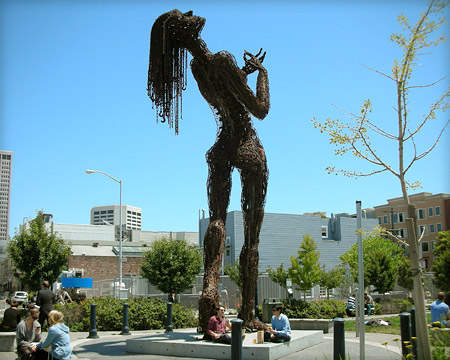See also: Street Furniture Overview
Public art is an important component of many street improvements. On a large scale, public art has the ability to unify a district with a theme or identify a neighborhood gateway. At a pedestrian scale, it can provide visual interest for passersby.
San Francisco’s Public Art Ordinance provides establishes the framework for the San Francisco Public Art Program. In San Francisco, two percent of the construction cost of civic buildings, transportation projects, new parks, and other above-ground structures to be allocated for public art. The city’s 2% for the arts program is administered by the San Francisco Arts Commission (SFAC).
This page focuses on the process and guidelines for installing public art in streets and sidewalks.
Process Overview
The process for designing and/or installing works of art in the public right-of-way will vary for different types of or project stakeholders. Artists, designers, community members, and City staff all play a role in the process.
Street Designers
Many street and transportation improvements are required to contribute 2% of the project budget to public art, subject to Arts Commission approval. The City’s Public Art Ordinance describes project thresholds that trigger this requirement.
If you are a designer working on a project that triggers the City’s Public 2% for public arts requirement, you will need to coordinate with the Civic Design Review Committee (CDRC).
The committee will review your project at three phases during the design process:
- Phase 1: Conceptual Design
- Phase 2: Design Development
- Phase 3: Construction Documents
See the CDRC homepage for more information.
Community Organizations
Public artwork installations generally involve greater neighborhood outreach and a more complex process than simple projects like street trees or sidewalk landscaping, and are typically carried out by a neighborhood or business organization. Community groups seeking to sponsor a civic art project are encouraged to reach out to neighbors and stakeholders early on and include them in the design process.
See Building Neighborhood Support
Permits
Community groups wishing to install artwork in the public right-of-way will require a Minor Sidewalk Encroachment Permit or Major Encroachment Permit from the Department of Public Works (DPW), depending on the scale of the project.
Project sponsors are encouraged to speak with a DPW permit plan checker early in the process to map out a permitting strategy for art instillations.
See Permit Process
Maintenance
For neighborhood- or corridor-wide street or sidewalk improvements, the sponsoring organization must have an agreed upon maintenance plan that spells out maintenance responsibilities. This is typically determined during the permit process. Project sponsors are strongly advised to meet with a DPW permit plan checker early on to discuss maintenance strategies.
To learn more about who is responsible for maintaining street and sidewalk features, see Maintenance.
Artists
The San Francisco Arts Commission selects artists for public commissions. See their Application Guide for Artists. The guide outlines selection procedures and submission guidelines for prospective artists.
If you are selected as an artist for a public artwork, Arts Commission staff will work with you on the various steps of the project including design, construction documents, public process and permitting.
Public Process
Many public art projects require a public process that allows community members to participate in the design process. The process will vary from project to project depending on the criteria established in the Call for Artists.
Art installed on public streets and sidewalks must be presented to the Civic Design Review Committee.
Permitting
The Arts Commission assists artists in getting their projects through the City’s permitting system. Public art commissions typically will require a Minor Sidewalk Encroachment Permit or Major Encroachment Permit from the Department of Public Works (DPW), depending on the scale of the project.
See Permit Process for more information
Official Codes & Documents
- Public Art Ordinance
(Section 3.19 of the Administrative Code) - Better Streets Plan (street design guidelines)
Design Guidelines
Street types: Downtown Commercial, Commercial Throughway, Neighborhood Commercial, Downtown Residential, Residential Throughway, Mixed Use, Parkway, Park Edge, Multi-Way Boulevard, Ceremonial, Alley, Shared Public Way, Paseo
Sidewalk zones: Extension Zone, Furnishing Zone, Frontage Zone
Guidelines
Location of public art
Public art should be located on streets and in public spaces with high volumes of pedestrian traffic, particularly at key points or intersections. It may also be located in areas where few people pass to create unique and special places for people to enjoy. Downtown streets and boulevards are particularly appropriate for the former, while stairways and pathways provide unique spaces, often distinct to San Francisco, that fulfill the latter.
Design of public art
Public art is unique to each situation; however, the following guidelines apply:
- Public art should be located so as to be a pedestrian amenity. A piece can act as a focal point in a park or plaza or present a “surprise” along a pedestrian path that rewards the passerby with visual interest.
- Consideration should be given to incorporating art into otherwise standard street elements such as light poles, benches, trash receptacles, and utility boxes.
- Art can provide information, such as including maps and signage, or be educational in regards to the history and culture of San Francisco’s neighborhoods and citizens. All installations do not need an educational mission, however—art can be playful.
- Public art should be accessible to persons with disabilities and must not be placed in a way that compromises the clear path of travel. Art pieces may require detectable warning strips around the base of the art piece.
Public art should be considered during the planning and design phase of development to more closely integrate art with other streetscape elements.
Maintenance
The Arts Commission is responsible for maintaining the city’s art collection.
Individuals who install public art in the public right-of-way through a DPW permit will be responsible for maintenance of the artwork.
For a more detailed description of maintenance responsibilities, see Maintenance.








 Copyright © 2015
Copyright © 2015